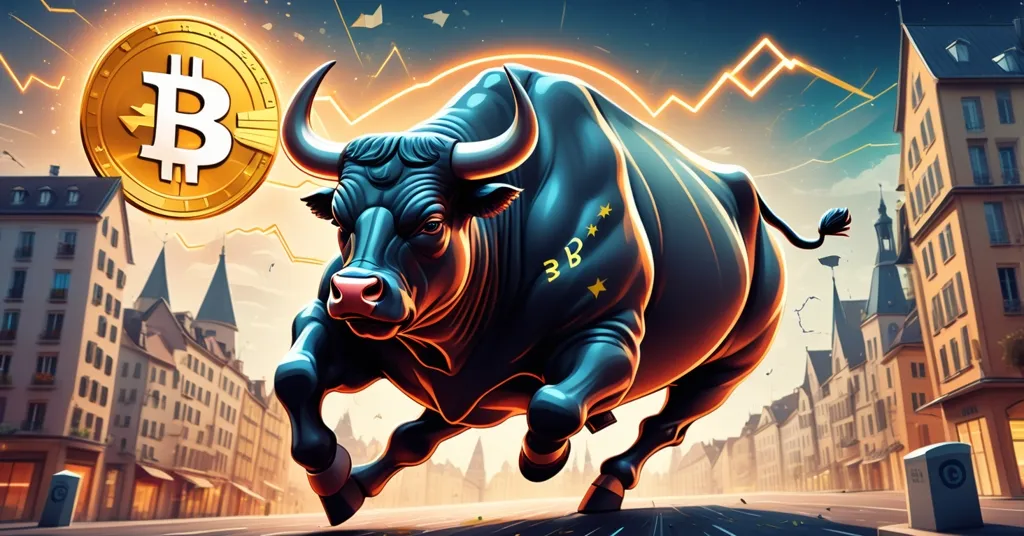J.P. Morgan Bullish on Eurozone Stocks: Impact on Bitcoin and Crypto Markets

J.P. Morgan’s Bullish Call on Eurozone Equities: What It Means for Bitcoin and Crypto Investors
Wall Street giant J.P. Morgan has just dropped a bombshell, upgrading Eurozone equities from a tepid “neutral” to a bold “overweight,” signaling a newfound confidence in European stocks. After lagging behind the U.S. market for much of the year, Europe’s markets are showing a pulse with a six-day rally—and J.P. Morgan thinks it’s time to jump in. But here’s the kicker for us in the crypto space: could this traditional market optimism ripple into Bitcoin and other digital assets, or will it pull capital away from our decentralized revolution?
- Rating Shift: J.P. Morgan upgrades Eurozone equities to “overweight,” betting on a rebound.
- Market Surge: European indices like the Stoxx Europe 600 hit new highs with a six-day winning streak.
- Crypto Angle: Economic recovery and rate cuts could influence Bitcoin as a hedge or risk asset.
J.P. Morgan’s Big Bet on Europe
Let’s break this down. When J.P. Morgan says “overweight,” they’re essentially telling investors to load up on Eurozone stocks because they expect them to outperform other regions. It’s like saying, “Put more of your chips on this table; the odds are looking good.” This upgrade comes after a rough stretch for European markets, with the Euro Stoxx 50—a major index tracking 50 of the largest companies in the region—trailing the U.S. S&P 500 by nearly 18% this year. Despite a decent 10.4% gain year-to-date, Europe’s been the underdog, and J.P. Morgan’s call is a sharp pivot.
Why the sudden optimism? Strategist Mislav Matejka and his team point to a handful of compelling reasons. First, valuations are dirt cheap. Compared to U.S. stocks, which often trade at sky-high prices relative to earnings, European companies are like discounted goods on a clearance rack—undervalued and ripe for the picking. Then there’s the resolution of a 15% tariff on EU goods, a nagging issue that had weighed on sentiment but is now off the table. Add to that whispers of economic stimulus from Germany, Europe’s powerhouse, and improving credit conditions—meaning businesses can borrow more easily to grow—and you’ve got a solid case for a rebound.
Matejka isn’t mincing words either.
“The time is coming up to turn bullish on Eurozone equities,”
he declared, framing this as a now-or-never moment for investors. Even political hiccups, like the budget mess in France, don’t faze him.
“Use the weakness to buy, as we believe that any pressure will not be long-lasting,”
he advised, basically saying, “Don’t sweat the small stuff; scoop up these stocks on the dip.”
Eurozone Rally: The Hard Numbers and Hot Sectors
The data backs up the hype—at least for now. European markets just recorded their best weekly performance since May, with the Stoxx Europe 600 Index, a broader gauge of the region’s stocks, soaring to a new peak. Mining and banking sectors are leading the charge, riding a wave of investor enthusiasm, while tech and food & beverage lag behind. The French CAC 40 index even eked out a 0.3% gain despite political drama, thanks to Prime Minister Sebastien Lecornu’s promise to untangle a budget deadlock. J.P. Morgan is projecting the Euro Stoxx 50 to hit 5,800 by year-end, a bold target that suggests more upside.
Specific sectors are catching their eye too. European defense companies are a top pick, fueled by geopolitical tensions and rising government spending. Think tanks, jets, and cybersecurity—nations are shelling out, and firms in this space stand to gain. Industrial, construction materials, and utility sectors are also on the radar, likely to benefit from infrastructure pushes or energy transitions. A neat example popped up recently with Legrand SA, a French electrical equipment maker, whose stock jumped 2.3% after acquiring Avtron Power Solutions for $1.125 billion. Deals like this hint at growth in niche areas tied to real-world needs.
Global tailwinds are helping too. The buzz around artificial intelligence (AI) advancements is spilling over from the U.S., giving tech-related stocks a lift, while expectations of Federal Reserve rate cuts—lowering borrowing costs worldwide—are stoking risk-on sentiment. It’s a spicy mix of hope and momentum, but as we’ll see, it’s not bulletproof.
Crypto Implications: Bitcoin and Beyond
Now, let’s pivot to what really matters to us: how does this Eurozone buzz impact Bitcoin, altcoins, and the broader crypto market? At first glance, a booming traditional market might seem like bad news for decentralized assets. If investors are piling into cheap European stocks, why would they bother with the wild west of crypto? But dig deeper, and there’s a case for Bitcoin to shine here.
For starters, Federal Reserve rate cuts, a key driver of this global optimism, tend to favor risk assets across the board. Lower interest rates mean cheaper money, and historically, that’s pushed capital into high-growth, high-risk plays—Bitcoin included. Look back at 2020-2021: post-COVID rate slashes sparked a BTC bull run to nearly $69,000. If the Fed eases again, we could see a similar effect, with Bitcoin acting as a speculative bet alongside European equities. J.P. Morgan’s bullishness on Europe might even signal broader institutional confidence, potentially drawing fresh eyes to crypto as an alternative asset class.
Then there’s the hedge angle. Bitcoin often gets dubbed “digital gold” for a reason—it’s seen by some as a safe haven when traditional markets wobble. If Europe’s rally falters (more on that below), BTC could attract capital fleeing equities. Plus, geopolitical tensions driving defense spending in Europe are the kind of uncertainty that makes Bitcoin’s decentralized, borderless nature appealing. Why trust a bank in a shaky economy when you can hold your wealth on a blockchain?
Altcoins and blockchain tech could have a play here too. Ethereum, for instance, powers decentralized finance (DeFi) platforms that could see adoption in a recovering Eurozone if businesses seek alternative funding outside traditional credit markets. And don’t sleep on blockchain’s potential in defense or AI sectors—think secure supply chains for military tech or tokenized AI projects. Europe’s focus on infrastructure and tech might open doors for crypto innovation if regulators don’t muck it up.
Risks and Counterpoints: Don’t Get Too Cozy
Before we pop the champagne, let’s talk cold, hard reality. This Eurozone rally isn’t a sure thing, and neither is any crypto spillover. Maud Giese, an investment strategist at Union Bancaire Privée, threw some ice water on the enthusiasm with a stark warning.
“Gains this year have been driven by multiple expansion. Sentiment could remain constructive in the near term, but if macroeconomic risks materialize, that might lead to a quick reversal,”
she noted. In plain English, stocks are climbing because investors are paying more for the same earnings, not because companies are suddenly raking in cash. If the global economy stumbles—think inflation spikes, energy crises, or a surprise recession—this house of cards could collapse.
Political chaos is another landmine. France’s budget circus is just one example; across the Eurozone, sluggish growth and policy gridlock could sap momentum. Germany’s rumored stimulus? It’s not a done deal. If it fizzles—or worse, if austerity hawks win out—investor confidence could tank. For crypto, this cuts both ways. A Eurozone flop might drive some to Bitcoin as a hedge, but let’s not kid ourselves: BTC isn’t immune to macro meltdowns. When risk assets bleed, crypto often takes a hit too, as we saw in the 2022 bear market.
Here’s the devil’s advocate take: J.P. Morgan’s bullish call might even hurt crypto in the short term. If institutional money floods into European equities, that’s capital not flowing into Bitcoin or altcoins. Wall Street isn’t exactly known for championing decentralization—they’d rather prop up the old guard than fund our revolution. And let’s be real: their 5,800 target for the Euro Stoxx 50 reeks of optimism bordering on hype. No one’s got a crystal ball, and I’m not buying any pie-in-the-sky predictions, whether it’s for stocks or crypto prices. We’re here for facts, not fairy tales. For more on their optimistic stance, check out the detailed analysis on J.P. Morgan’s bullish outlook for Eurozone equities.
Blockchain Opportunities in Europe’s Revival
Let’s zoom out and think bigger. If Europe does pull off this recovery, there’s untapped potential for blockchain to sneak into the picture. Defense spending, a key focus for J.P. Morgan, screams for decentralized solutions. Military supply chains are notoriously complex and prone to fraud—blockchain’s immutable ledgers could secure them, ensuring transparency for government contracts. Companies in the Euro Stoxx 50 dabbling in tech or logistics might quietly adopt distributed ledger tech if costs align.
AI is another wildcard. Europe’s catching the AI fever, and pairing it with blockchain could birth decentralized platforms for data sharing or tokenized machine-learning models. Imagine European startups using Ethereum smart contracts to fund AI research without begging banks for loans. Even utilities and construction, sectors J.P. Morgan likes, could tap blockchain for energy trading or project financing—think peer-to-peer solar grids or tokenized infrastructure bonds. It’s speculative, sure, but the seeds are there if Europe stops overregulating crypto into oblivion.
As Bitcoin maximalists, we might scoff at altcoin-heavy use cases, but let’s not pretend BTC can (or should) do it all. Ethereum and other protocols fill niches—DeFi, NFTs, enterprise solutions—that Bitcoin’s laser focus on being sound money doesn’t cover. A rising Eurozone could be a testing ground for these innovations, assuming bureaucrats don’t choke them with red tape. That’s the dream of effective accelerationism: push the tech forward, disrupt the status quo, and let freedom win.
Key Takeaways and Questions for Crypto Enthusiasts
- What sparked J.P. Morgan’s bullish outlook on Eurozone equities?
Cheap valuations, a resolved 15% EU tariff issue, potential stimulus from Germany, and better credit conditions are fueling their confidence. - How are European markets performing compared to the U.S.?
The Euro Stoxx 50 lags the S&P 500 by about 18%, but a recent six-day rally and a 10.4% year-to-date gain signal a comeback. - Could Federal Reserve rate cuts boost Bitcoin alongside European stocks?
Absolutely—lower rates often drive capital into risk assets like BTC, as seen in past cycles, potentially amplifying gains if sentiment holds. - What risks could derail this Eurozone rally and impact crypto?
Political instability in France, macroeconomic shocks, and overblown optimism could tank stocks, with Bitcoin either benefiting as a hedge or suffering as a risk asset. - Are there blockchain opportunities in Europe’s recovery?
Yes, defense, AI, and infrastructure sectors could adopt blockchain for secure supply chains, tokenized projects, or decentralized funding if regulation allows. - Will traditional market optimism hurt or help crypto adoption?
It’s a coin toss—capital might flow away from crypto into equities, or a rising tide could lift all boats if Bitcoin’s hedge narrative holds strong. - Should crypto investors care about Eurozone equities?
Yes, traditional market shifts influence institutional money flows and risk sentiment, which can directly affect Bitcoin and altcoin valuations.
So, where does this leave us? J.P. Morgan’s bet on Eurozone equities is a loud wake-up call that traditional markets still have fight in them. For crypto diehards, it’s a chance to watch how Wall Street’s moves ripple into our space—whether Bitcoin emerges as a safe harbor or gets sidelined by shiny new stock plays. One thing’s for sure: the game’s heating up, and between cheap European stocks and our unstoppable blockchain tech, there’s plenty of action to track. Stay sharp, stay skeptical, and let’s see who comes out on top in this financial tug-of-war.



